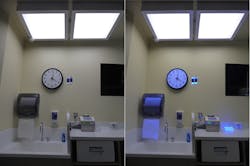Leviton Viscor delivers SSL with UV-A continuous disinfection technology
The Leviton Lighting brand Viscor has announced the integration of ultraviolet (UV) LED technology into the Visioneering line of LED luminaires, enabling the solid-state lighting (SSL) products to combine continuous disinfection and visible light delivery. Specifically, the LRTH-DFX troffer-style luminaire radiates the UV-A-band (315–400-nm) energy that has been shown to deactivate or kill bacterial pathogens such as MRSA (methicillin-resistant Staphylococcus aureus) and E. coli (Escherichia coli). The new luminaire is the result of Leviton licensing the 365DisInFx UV-A technology from GE Current, a Daintree Company, back last fall.
Current first introduced the UV-A technology at LightFair International back in 2018. That came after companies such as Kenall and Vyv (formerly Vital Vio) had promoted energy in the visible violet region at 405 nm for similar disinfection capabilities. In either case, the radiation requires significant hours to succeed in the deactivation task. Leviton cites research that found UV-A radiation at 3W/m2 on a surface can reduce the presence of MRSA by a factor of 99.7% over a period of eight hours. The Lighting Research Center (LRC) at Rensselaer had also tested the Current technology and found it effective. Moreover, humans can be safely exposed to that power level and duration each day, according to IEC standards for photobiological safety.
“Viscor is proud to offer the first Leviton Lighting luminaire featuring 365DisInFx™ UV-A technology under the Visioneering brand,” said Pierre Legare, executive vice president at Viscor. “With the continuous disinfection provided by LRTH-DFX, we hope to support cleaner spaces that will allow building occupants to focus more on the activities they are doing rather than the cleanliness of the spaces they are in.”
We did not cover the licensing deal between Leviton and Current when it happened last fall, due to some confusion as to how the technology would be applied and what exactly Leviton had licensed. That partnership came on the heels of Current having announced the 365DisInFx brand simultaneously with the launch of UV-C-band (100–280-nm) puck-style fixtures. While most UV-C products are intended to use relatively high output levels and deactivate pathogens immediately, the Current pucks operate at output power levels safe for people and can be used continuously. Current has combined the UV-A and UV-C products within its 365DisInFx brand portfolio, with the 365 prefix indicating continuous usage.
Apparently, Leviton has only licensed the UV-A technology for now. And Current does not manufacture UV-A LEDs. The company hasn’t said whether it uses custom or off-the-shelf UV-A packaged LEDs. But the license presumably provides Leviton with access to the LEDs and the control scheme developed by Current.
Leviton will target healthcare applications with the new products, and those facilities need such technology to fight HAIs (healthcare-associated infections). We covered that need in a UV feature back in the spring. Leviton also said it would target the education market and even commercial office spaces with the new products.
The Leviton announcement alluded to the COVID-19 pandemic as driving the market for LED-based disinfection products. “As we return to regular activity in our shared spaces, safety will continue to be the highest priority,” said Richie Westfall, vice president and general manager for Leviton Lighting & Controls. “The LRTH-DFX troffer integrated with 365DisInFx UV-A technology fills a critical need by enabling continuous disinfection without requiring occupants to leave spaces.”
But the announcement did not specifically mention the germicidal efficacy of the 365DisInFx UV-A technology relative to a viral pathogen such as SARS-CoV-2. Without question, instantly-acting, high-powered UV-C systems would be preferred in the viral case. Still, any protection would be welcomed. Back in May, we wrote about research that confirmed visible light at 405 nm could deactivate SARS-CoV-2 over time. We don’t know if the UV-A technology will yield similar results.
LEDs Magazine chief editor MAURY WRIGHT is an electronics engineer turned technology journalist, who has focused specifically on the LED & Lighting industry for the past decade.
For up-to-the-minute LED and SSL updates, why not follow us on Twitter? You’ll find curated content and commentary, as well as information on industry events, webcasts, and surveys on our LinkedIn Company Page and our Facebook page.

Maury Wright | Editor in Chief
Maury Wright is an electronics engineer turned technology journalist, who has focused specifically on the LED & Lighting industry for the past decade. Wright first wrote for LEDs Magazine as a contractor in 2010, and took over as Editor-in-Chief in 2012. He has broad experience in technology areas ranging from microprocessors to digital media to wireless networks that he gained over 30 years in the trade press. Wright has experience running global editorial operations, such as during his tenure as worldwide editorial director of EDN Magazine, and has been instrumental in launching publication websites going back to the earliest days of the Internet. Wright has won numerous industry awards, including multiple ASBPE national awards for B2B journalism excellence, and has received finalist recognition for LEDs Magazine in the FOLIO Eddie Awards. He received a BS in electrical engineering from Auburn University.




![The DesignLights Consortium continues to make progress in shifting outdoor lighting products and implementation practices toward a more restrained and thoughtful strategy. [Image does not represent a DLC qualified fixture.] The DesignLights Consortium continues to make progress in shifting outdoor lighting products and implementation practices toward a more restrained and thoughtful strategy. [Image does not represent a DLC qualified fixture.]](https://img.ledsmagazine.com/files/base/ebm/leds/image/2024/08/66be810888ae93f656446f61-dreamstime_m_265700653.png?auto=format,compress&fit=&q=45&h=139&height=139&w=250&width=250)
